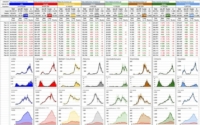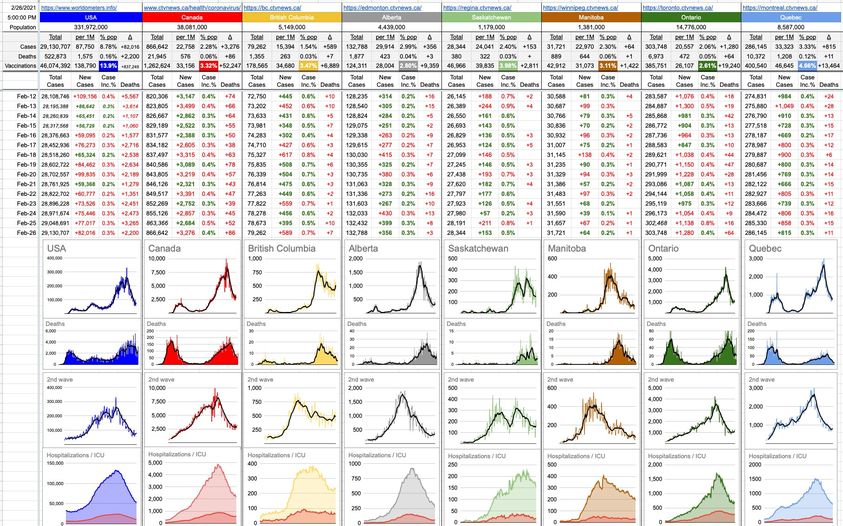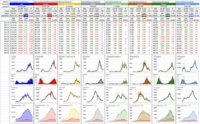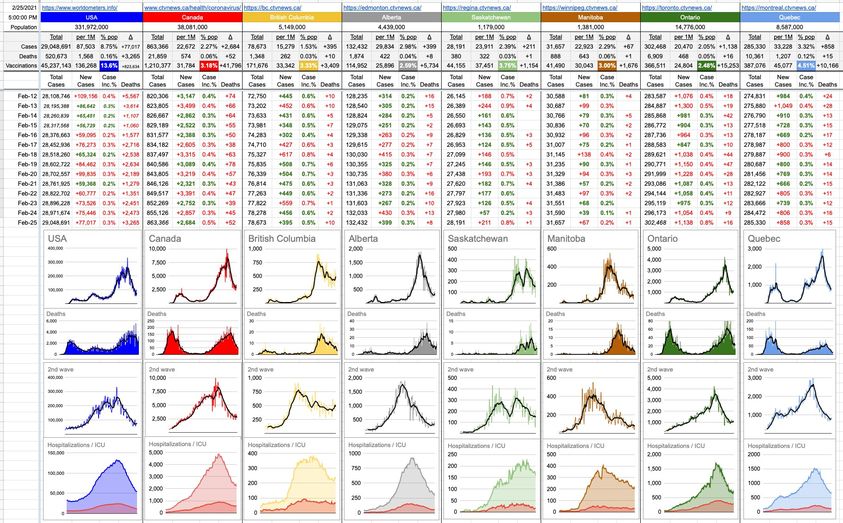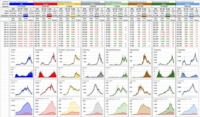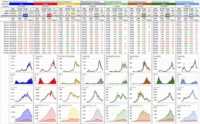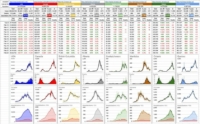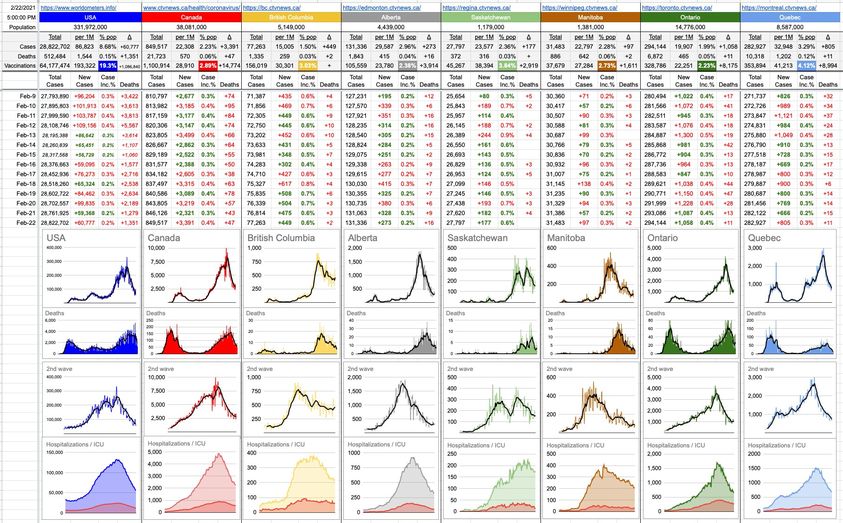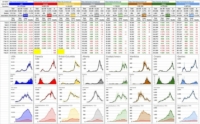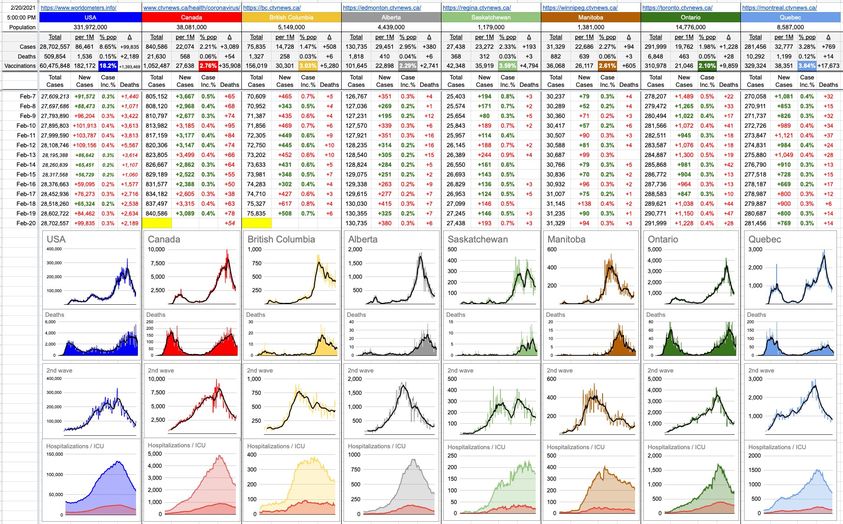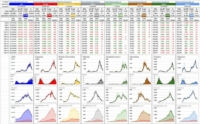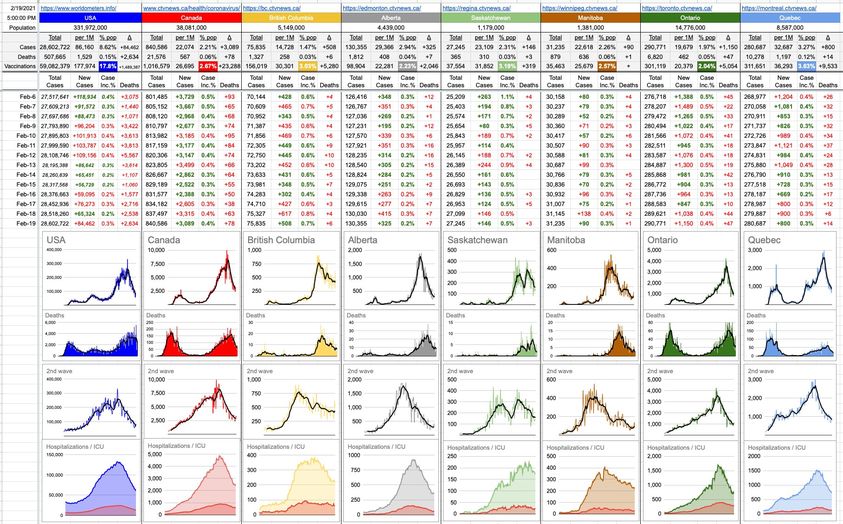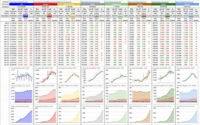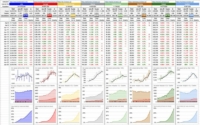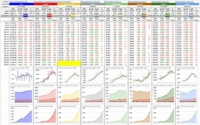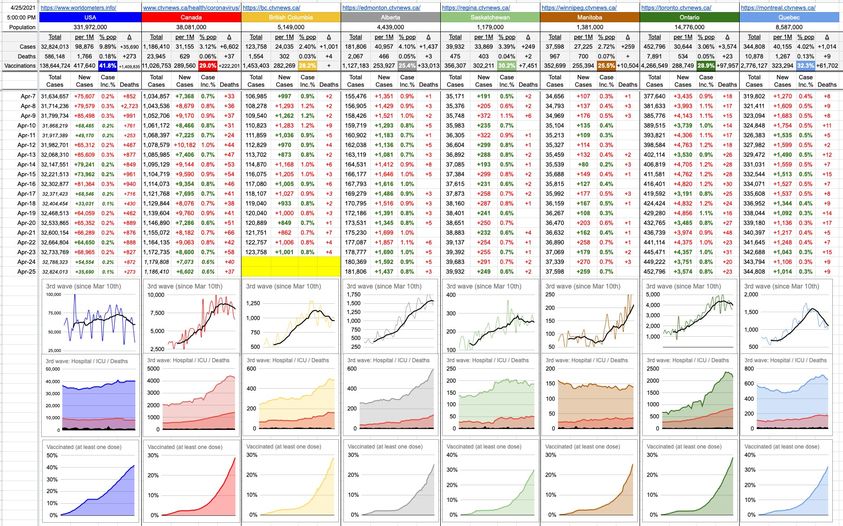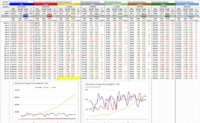February 26, 2021
When you bash your finger with a hammer, yelling out “Golly!” doesn’t quite have the same clout, effect and/or relief than some other choice word. Why is that? There’s actually a word that describes it:
Lalochezia: (n.) the emotional relief gained from using abusive or profane language
We grow up attaching “value” to certain words, and that emotional release they offer is the payoff for all the investment over the years… the small outbursts and exclamations load the profanity cannon, ready to blast when needed. And it’s all inward-facing. There’s nothing magical about the words we all use, and if we’d grown up in a household where different words were used as exclamations of the sort, we’d have learned those associations instead… and then, when you’re in the parking lot of the supermarket and slam your finger shut with your car door, whatever you scream out wouldn’t be met with looks of disapproval from nearby mothers with small innocent children who’ve obviously never heard such vile language. Ah, what a great memory.
Interesting though… for those who speak more than one language… can you swear “effectively” in something other than your primary language? Of course you know all the bad words (it’s the first thing you learn in any new language…) but does it have the same effect?
I was out riding my bike today, lost in thought. A beautiful sunny windy day… perfect.
The vast majority of the time, I think in English… but I was composing a business letter in my head, in Spanish, so that’s where my brain was at when someone decided to walk straight onto the bike lane, crossing it without looking. I slammed on my brakes and skidded to a stop; nobody was hurt, but I did instinctively find myself yelling out a profanity… and so, one might wonder… in what language?
The answer is… English. Whatever fight-or-flight reflex that gets triggered… whatever part of the brain gets activated in this situation… it’s separate from the intellectual part, regardless of whatever language in which it was currently engaged. I switched instantly from intellectual, verbose Spanish… to one single well-known English word. And, in doing so, switched my brain entirely back to English, in which the ensuing conversation took place.
For those pedestrians who also enjoy the sunny windy beautiful fresh air, do keep in mind that if it’s a bike lane, the bikes have the right of way. And if you screw up and walk in front of a bike, causing the cyclist to slam on the brakes and instinctively yell something, don’t get all indignant. Just apologize and move on. Nothing got hurt except your fragile ego. You have the right to be pissed off… just not at me.
Speaking of pissed off, there will be a lot of pissed-off anti-mask, anti-vax, anti-intelligent people, who were all ready to invade the BC Ferry service and head to Victoria for Freedom Rally tomorrow. Thanks to high winds, all sailings are cancelled. How unfortunate. Perhaps they can quickly organize something locally. Given the wind situation, might I suggest… to all of them… go fly a kite.
And for everyone else, here it is in eloquent Spanish, now that my brain is back in that mode: Espero que tengan un muy buen fin de semana y que disfruten!
25 Likes, 1 Shares
February 25, 2021
Leap years… leap seconds… even, with some calendars, leap months… these tiny (or not-so-tiny) course corrections are necessary because, unfortunately, the earth doesn’t rotate exactly every 24-hours, nor does it orbit the sun exactly every 365 days. At the moment, one rotation is 23 hours, 56 minutes, 4.09053 seconds. One year is 365.2422 of those rotations. These are not nice, round numbers to work with… and even if they were, the earth is slowing down, so it’d all have to change eventually. In fact, they change continually.
The people who manage all this keep careful track of it, and often fiddle with it without us even knowing. If you weren’t aware of it, you certainly would’ve missed the extra second that was tagged on to New Year’s Eve in 2016. Approaching midnight, the time went from 11:59:58… to 11:59:59… to 11:59:60 (!) before continuing on to 12:00:00am, January 1st, 2017.
If those little adjustments didn’t take place, the errors would accumulate. The sun would start rising and setting at weird times. It would snow in Spring and get super-hot in late Autumn. And, once in a while, having not kept up with the corrections, some abrupt fixes would need to be implemented.
The calendar we’re all familiar with is the Gregorian calendar, which was preceded by the less-accurate Julian calendar… and not everyone switched over at the same time. While the Gregorian calendar was adopted in places line France, Italy and Spain back in 1582, it wasn’t until 1752 that the U.S. and Canada switched over… and since the Julian calendar is less accurate with respect to leap-anythings, it was falling further and further behind. In 1582, it required a 10-day adjustment. When Canada and the U.S. did it, it required 11 days… and when Turkey and Greece finally made the change, less than 100 years ago, they had to drop 13 days from existence. History is full of stories of landlords who tried to charge a full month’s rent during those half-month switches; you can imagine how popular that was…
Indeed, that’s what happens when you keep letting errors pile up; they become more difficult to correct down the road.
All of this is relevant because of the data and charts you see attached to this little blurb… and it has to do with the inconsistency of the data with respect to testing and cases and deaths and vaccinations. Like I wrote about recently, if you have one watch, you know what time it is. If you have more than one, you’re not so sure.
I have managed, I think, to consolidate and normalize all the data so that going forward, it’s not quite so apples-to-oranges. But to get things to align, there’s a bit of a Julian/Gregorian leap-year adjusting to do. In some calendar switchovers, a February 30th was added just to make it work; think of it like that.
Actually, it’s not so bad… but here’s what’s changed, if you’ve been following closely:
The U.S vaccination number has gone down. I’d previously been getting a number that was confusing with respect to its allocation of first and second doses. The number now is up-to-date, and certainly only first doses. It’s also dropped the vaccinated population percentage from 20% down to less than 14%.
While it’s important to know how many doses have been dished out, it’s more important to know how many individuals have had at least one. Now, for all the data, … U.S., Canada and all the provinces, those numbers should be accurate and far-more up-to-date than before for “at least one dose” – as well as the vaccinated population percentages that go along with it. Note how Quebec seems to be way ahead of other provinces; in a way, they are… that’s an accurate representation of first doses they’ve injected. Along with that goes the not-so-irrelevant-fact that they still have yet to dish out a single second dose.
The other number that changed radically is Ontario. They had 1,138 new cases today, and that’s what I wrote down… even though the case counts grew by 5,000. Why? Because the new data source is a bit more ahead of the game; they tap into the individual health departments instead of reporting the single province-wide number that’s relayed daily. Ahead or behind the curve isn’t as important as it being the correct curve, and that representation hasn’t changed. Now that everything is newly-aligned, it should work just fine going forward… but looking at today’s data feels a bit like those lost 10 or 11 days… like things don’t add up. But they do.
16 Likes, 2 Shares
February 24, 2021
It’s always good practice never to get version one point zero of anything… wait a bit, let them work the bugs out, let them fix what they got wrong. New car model, completely redesigned…? Maybe last year’s model is ok. iPhone update? Sounds good… but maybe wait a day or two till a lot of people have done it… just in case it “bricks” the phone. It makes sense.
A lot of intelligent, educated and well-vaccinated people with every intention of getting the C19 vaccine – eventually – had (and still may have) that level of uncertainty. That’s fair, though it’s turning out to be a concern that’s irrelevant to most of us because hundreds of millions of people will have gotten their shot before we do.
Would I have been first in line on day one to get the vaccine? Actually, yeah… I would’ve… but understand why many people would’ve wanted to wait a bit.
We’re well past that point by now. There’s a lot of data out there, and most of it is agreeing with what was expected, and most of it is even better.
And, for those that waited, now you’re on to version 1.1 or maybe 2.0… because the Moderna vaccine has now been modified to directly combat the South Africa variant. Those who had the old version can get it line for a booster down the road. Those who haven’t had it yet will get the new one… a silver lining of benefit to the cloud of having to wait this long. The irony, here in Canada, is that by the time we get them, we won’t need them – we’ll be enjoying the herd immunity offered by the rest of the world.
The arguments these days are all about whether we can actually end this pandemic, or whether it’ll turn into a ho-hum version of seasonal illness. COVID-19 may become just another version of coronavirus that never goes way, but is easily defended against via vaccine or treatment. Or, interestingly… the vaccines are so good that they may eventually eradicate it. We shall see.
… and, might I add, this is a much better discussion to be having compared to the one that was springing up a year ago… the “Can we even develop a vaccine against this thing?” That part of it has been answered, and answered well. Ask me next year about the questions we’re asking today.
29 Likes, 3 Shares
February 23, 2021
Imagine a big map of North America… now, take 100 pins and stick then on the 100 biggest cities. Now imagine trying to find the shortest path that visits every city exactly once. Imagining the problem isn’t difficult. Solving it is a different story.
To solve it, you’d create a table of all the distances from once city to another. Each city would have a list off 99 entries below it… Vancouver to Seattle, Vancouver to Portland, Vancouver to Miami… etc. The total number of distances to consider would be 100 x 99… and yes, even though Vancouver to Seattle is the same as Seattle to Vancouver, you need the entry twice in the table because, in the solution, you’re not sure from which direction you’d be approaching.
Setting up a computer to solve this is simple: Generate every version of path through all cities, add up the little distances, and keep track of the best one so far. Once you’ve cycled through all the combinations, you’ll have the answer. This is easy, in theory.
It gets a bit more complicated in practice.
How many combinations of paths are there? Starting in any city, there are 99 options for the next one. Once you get there, there are 98 choices for the next one. After that, 97. Therefore, the number of combinations is 100 x 99 x 98 x… all the way down to x 1. That’s 100 factorial (100!) which equals… a really big number. How big? It’s a number with 157 zeroes after it. The number of particles in the universe is a number with 80 zeroes after it. How long would it take to analyze every combination? A few zillion years. Not too practical. That’s how long it’d take to find the perfect solution… but how about a “good enough” solution? Not 100%, but how about 95%?
Back in 1993, when I wrote a program like this, it took about 20 minutes. With today’s horsepower, any home computer could do it in less than a minute.
That’s quite a difference, and for all practical purposes, good enough. The traveling salesman can spend a few extra days on the road and burn a bit more gas… not a big deal. Good enough.
One strategy to solve big problems down to a “not perfect but good enough” level is what’s called a “Genetic Algorithm”… it’s what I used, and it’s pretty cool, so now you get to hear about how it works.
Out of the zillions of possible 100-city-tours, imagine you generate a bunch of random ones… say 10,000 of them. Just create 10,000 unique paths through those 100 cities, totally randomly. Some, like the ones that begin Vancouver-Miami-LA-Toronto… will be awful. Ones that start Vancouver-Seattle-Portland are likely to look better. But… whatever they look like, out of the 10,000… take the best 100.
Now… here comes the cool part… you take those 100 – call them the “first” generation, and figuratively “breed them” to each other. You pretend they’re like parents having offspring… you splice half of one, splice half of another, join them together… and now you have a whole new potential solution. It might be better than one or both parents… it might be worse. Doesn’t matter… breed all the combinations… now you have a whole new generation of 10,000 possible solutions, and they’re almost all certain to be better than their respective “parents”. And now you take the best 100 of those and do it again, and create a third generation. This is like instant evolution… but it doesn’t take 9 months and lots of diapers. It takes a few milliseconds… and that’s the beauty of it… after less than 1,000 generations, which doesn’t take long at all, you have a surprisingly good solution. Already north of 90%.
Modelling 100 cities with nothing but the distances between them is very simple. Modeling the infrastructure within which a virus may live and thrive and propagate is a lot more complicated, but once it’s in place, searching for a solution might look similar. Here’s a random formula for a mRNA vaccine… was it effective? Try 10,000 random formulas, pick the best 100… splice them, mix them, test them… and do it again. And again and again. Pretty quickly, you will have honed-in on realistic possibilities.
This isn’t quite how it came about… but when people wonder how it’s possible to come up with an answer to a supremely complicated and unknown problem, it’s strategies like this… which have the capability of very-quickly zeroing in on viable solutions drawn from an unfathomably huge search-space of potential solutions.
Finding the perfect vaccine might take decades… if not centuries. But a vaccine doesn’t have to be perfect.
How long would it take to find one that’s good enough… say, 95% effective…?
That question has been answered.
14 Likes, 3 Shares
February 21, 2021
The numbers will all be accurately updated tomorrow. In the meantime…
There once was a doctor named Henry
Whose gentle words, kind and most friendly,
Said, “Please, just stay home,
This is no time to roam”,
But for many, those words were just merely…
A voice full of spite… so annoying!!
“We’d rather be out, and enjoying
The pubs and the fun,
And the parties and sun,
We’ve just had it with life that’s so boring!!”
The numbers crept up, somewhat slowly
But suddenly jumped… holy moly…
The hospitals slammed,
And the ICUs jammed,
“Oh no”, said the people… “if only…
We’d listened when last we were told
Those words that will never get old:
Be calm, safe and kind,
We can leave this behind,
But it’s not just like some common cold.”
OK… the good news is that the numbers haven’t yet exploded off the chart… but they’re at that point where it could go either way…. and here’s the deal… as long as they stay low, I’ll keep writing about interesting things… like vaccines and science and bitcoins and my life and my dog and whatever else has kept you around, reading this. Maybe I’ll bash Trump a bit more, too… just for old-time’s sake.
And if numbers go up, you will all instead be subjected to more terrible poetry. As per above, it’s up to you. You’ve been warned. Don’t make me do it. Please.
37 Likes, 3 Shares
February 20, 2021
Vaccines have been around long enough that now we are getting more and more real-world data. Forget the tiny samples extrapolated to the general population… these aren’t trials of a few select people, or Phase 1 or 2 trials. These aren’t good guesses. One recent study from Israeli data has a sample set of 500,000. I think it’s fair to assume that whatever those numbers imply, they’ll apply to everyone.
In summary, after getting the second dose and waiting two weeks, you have a 96% chance of not getting sick at all. You have a 99% chance of not dying from C19, even if you do get sick… because if you do get sick, it’s exceedingly unlikely to be a serious course of illness.
Those are the numbers people need to hear… and, around here, in B.C… perhaps more-so than other places. We are the number one province for disobeying orders from the PHO, and that’s worrisome, especially with Spring Break coming up. If we were all well on our way to being vaccinated, that’d be a different story. The issue is that significant numbers of people aren’t following the rules, and adding vaccine delays and more contagious variants to that means almost certain exponential growth in daily cases. We might easily be heading into the “Wow, didn’t see that coming” territory… except, now, we do it see it coming. It’s blatantly obvious, and it’d be unfortunate to see it all go to hell one more time.
Almost certainly, it’d be the last time… because by the time the next wave subsides, the science implies the virus would be out of gas… nowhere to hop to in any meaningful way; relegated to the nooks and crannies of rare illness that pops up in a while. But we’re at least a year away from that, and it can be a very bumpy road… a road where even if the numbers don’t blow up, we’ll be hearing a lot of constant whining: “Why can’t we do this, why can’t we do that… while at the same time we’re allowed to do these other things…”
These rhetorical questions are easily answered: Because the majority of infections are happening in completely-avoidable social settings. That’s it. If you could be trusted to visit someone’s house, but be outside and far apart and wear masks… go right ahead. Except, you can’t… because over and over we see examples of people saying to hell with it; my mental health is more important and I’ve had enough. I’m going to visit and I’m going to hang out and there’s nothing anyone can do or say to stop me.
It’s true… around here, there’s no threat of going to jail. There’s no threat of a fine that really hurts; it’s just a slap on the wrist. The consequences just aren’t there to serve as a deterrent, because the deterrent is supposed to be self-evident…. short-term pain for long-term gain. I (and many others) will tell you: “Stick to the program now, and we will all be out of this sooner.” If enough people listen, we’ll be ok… yet, people were disappointed that recently, restrictions weren’t lifted.
We could be back at the “hang out with 6 friends” thing soon. In fact, we could’ve been there right now had people followed the rules a bit better. No Yaletown rooftop parties. No games nights. No karaoke. At least, not yet. We’re still at the point where a few people can ruin it for everyone.
I’m not here to judge or tell you what to do. I am just here to tell you what might happen, and the only evidence I’ll provide is information that’s available everywhere. Look at places that are well-along the path of vaccination. Look at the places where they’ve eradicated the virus, and the militant steps they’re taking to keep it out. For us, presently, neither of those options are relevant… so… here it is again. I’ll repeat what we’ve heard from Dr. Henry a thousand times: It’s up to us.
27 Likes, 2 Shares
February 19, 2021
Two somewhat-related items as we head into the weekend…
Yesterday’s post sparked some interesting discussion; it was supposed to be about the difference with arguing opinions versus facts. When it comes to English or Political Science, there are opinions. When it comes to Math, there are facts… and just because the facts were taught incorrectly (or not at all), it does not negate their validity. The big difference between Math teachers and English teachers is that one has more “wiggle room” than the other. Or, should. Thinking back to elementary school, grade 5 to be exact, I remember this interaction… and it bothers me to this day. I am a big fan of good teachers (and have written about, and will do so in the future as well) – many I’ve experienced in my lifetime.
But school teachers… public or private / elementary or high-school… it’s always hit or miss.
On this day back in 1978, the English teacher who was now also teaching Math… asked the class something like “Of the numbers from one to ten, which ones go into twenty?”
Hands shot up and kids were called upon…
“Five!”
“Yes”
“Ten!”
“Yes”
“Four”
“Yes – very good”
And then I put up my hand and said, “Don’t they *all* go into twenty? I think you mean which ones go into twenty *evenly*”.
“What?”
“Like nine… it goes into twenty twice, but not evenly. Remainder two”
And instead of “Oh, well… yes, you’re right…”, what she said was, “Oooohhhh… boys and girls, looks like we have a little math genius in the room!” – which of course was met with derision and “Hee Haw” from around the classroom. Up yours, Mrs. T.
Hey, teachers… your kids are impressionable. They remember stuff like that. Here we are, more than forty years later.
And speaking of education, and possible lack thereof, the messaging around vaccines has not been great. There are people who “get it”, but they are not the ones that need convincing, explaining or educating. They understand, and they will get their vaccine as soon as they’re able.
The messaging towards the vaccine-hesitant has been awful, to the point of making things worse. Now, finally, we are on the cusp of seeing ramped-up production and delivery… and now the issue will simply be that people don’t want to get vaccinated… and when you ask an otherwise well-informed person why, you’ll hear things like:
“The vaccine isn’t 100% effective”
“It doesn’t work against the new variants”
“You can still be contagious after you get it”
“We’re told we still have to wear masks and socially distance, so why bother?”
Most of that has some truth to it, but that’s totally missing the point. Yes, 95 isn’t 100. It seems to work just fine against the new variants, but we won’t know for sure till we have some data. Yes, for a period of time, you can still be contagious… but after two weeks, almost certainly not. And, finally, yeah… we still have to wear masks and socially distance because we’re not all immune… because, guess what, we’re not all yet vaccinated.
But, for whatever reason, the clarity of the message gets lost with all of the more-effective fear-mongering… and, as a result, a third of the U.S. military have refused to get vaccinated. Some 60% of Ohio nursing-home workers have declined it. Ultimately, as per the latest poll, half of Americans would refuse the vaccine today… a number which is ironically higher in Black in Hispanic people; ironic, because they generally have a higher chance of getting the disease… and worse outcomes. Data has shown that two weeks after getting the second dose, your chances of dying from C19 are near zero. At worst, you’ll suffer what seems to be a conventional cold… but that message is not getting through.
This is the end-result of awful, inconsistent messaging from former leadership in the U.S…. but here in Canada, while the numbers are better, they’re still alarmingly high… probably because for people who like to see things in terms of a binary solution… good/bad black/white right/wrong… no matter how good vaccine outcomes might be, there’s always the caveat… it’s not perfect. Therefore, it’s useless.
The messaging needs to be consistent. It needs to be hammered home unequivocally. And it needs messaging from trusted experts, not politicians. Not English teachers posing as Math teachers whose attitude is to lash out at those that don’t agree.
At the end of the day, it’s all about education… and that needs to be happening a lot better than it is now.
31 Likes, 4 Shares
Share...
April 27, 2021
Take a map of Canada and tip it to the left… like rotate it about 45 degrees. Now you have British Columbia on the bottom. If you imagine the population being 38 million little specs of dust all over the map, you shake it a bit, and the specs all fall towards B.C. To some extent, this is the understood path of migration of people in this country. Should you choose to move from wherever you are, there’s a good chance you’re heading west. Vancouver is continually voted one of the best cities in the world to live in; choosing to move somewhere around here is pretty sane.
On the flipside, our neighbours to the south do it very much the other way around. First of all, you have to tip the U.S. map 45 degrees to the right. That leaves Florida on the bottom. And then, the little shakeout is not the sane people… quite the opposite. How else can you explain disproportionate insanity that seems to emanate from The Sunshine State.
News headlines from Florida are in a league of their own… things like “Thousands of gun owners in Florida planning to ‘shoot down’ Hurricane Irma”
In fact, whenever you see a news story that starts off with “Florida man…”, you know you can expect the crazy. It’s such a thing that there’s even a Twitter account of exactly that – a collection of Florida Man headlines… with gems like:
Florida Man tries to rob GameStop while wearing transparent bag on his head
Florida Man denies drinking and driving, says he only swigged bourbon at stop signs
Florida Man stabs tourist despite having no arms
Florida Man asks trooper if he can leave the scene of crash to get more meth
Florida Man bursts into ex’s delivery room, fights her new boyfriend as she’s giving birth
Florida Man bored, calls 9-11 to talk about Hitler
Florida Man tries to evade arrest by cartwheeling away from cops
Florida Man trapped in unlocked closet for two days
This is an endless list that grows on a daily basis, and serves as a perfect introduction to the “crazy of the day” – a private school in Miami that’s barring contact between students and vaccinated teachers. Because, somehow, vaccinated teachers may pose a threat.
The school’s position: “Tens of thousands of women all over the … [Continue Reading]
April 26, 2021
I play around a lot with my 3D printer… it’s here, beside me, in my home office, and the little series of sounds it makes while operating is good background noise; it’s not distracting… on the contrary, it helps me focus. And, at the end of it, you end up with some interesting (and sometimes useful) object. I have an endless list of things I and the kids have designed and printed… and I’m fascinated with the technology. This printer is already three years old, and there have been upgrades to it… many of which I’ve printed myself. How’s that for innovation – instead of sending you a part, they just send you a 3d blueprint – then you print the thing yourself. So cool.
That being said, it’s still an evolving technology. Some of these prints take several hours… and sometimes, halfway through them, just when you think it’s all going well, one little thing goes wrong and the entire thing is ruined. We’re all familiar with that concept these days.
I’m looking forward, as the technology progresses, to being able to print things with better consistency, and with more and more detail… and with a greater variety of materials. This one only does plastic, but this is the same technology that’s printing metal. And food. And houses. And human organs… one day.
Soon, these things will be printing with the finest detail possible… atom by atom. What would I print with that?
The first thing I would print is the tiniest violin imaginable… suitable for playing the sympathetic music due to the likes of the soon-to-be-former owner of the Corduroy restaurant on Cornwall, Rebecca Matthews… and Alaska Republican state Senator Lora Reinbold.
These two have misunderstood something, and they’re beginning to pay the price for it. What they don’t understand is that nobody gives a crap about them, and long after the issues of the day have become non-issues, they will be left holding the bag for the misguided messages they were propagating.
After Rebecca Matthews loses her business license, liquor license and whatever court case the City of Vancouver throws at her, she’ll be wondering where all of her supporters have gone. Where are the people that were chanting “Get out!” to provincial health officials when she was illegally operating her restaurant? Where … [Continue Reading]
April 25, 2021
Lazy Sunday… good one to sit on the couch and not do much… but a special shoutout to all my fellow Gen-Xers who managed to secure an AstraZeneca vaccine and are feeling somewhat hungover. Like the old days, the hangover fades after a few days… and, like in those old days, you sit around and wonder if it was worth it. And the answer back then is the same as the answer today.
Well worth it, eh… we’ll be all ready for next weekend. Let’s meet at Luv Affair or Twilight Zone… then maybe head over to the Purple Onion after a bite in Gastown somewhere.
OK, so this isn’t 25 years ago… none of that is likely to happen… especially since none of those places are still around… but this hangover is still totally worth it.
Back tomorrow with updated numbers across the board… then, with a clearer head, we’ll see where we’re at…
April 24, 2021
The last time I wrote about India, it was to congratulate them on how well a country with some pretty awful conditions for large parts of its population was managing to keep things so well under control. It is actually possible to keep people in less-then-ideal situations safer than you think, and there’s no better example then our own Downtown East Side… which has pretty much reached what’s being called “significant herd immunity” thanks to the persistent effort of getting all of the at-risk and homeless population vaccinated… even resorting to bribing them with $5 gift-cards to do so. Whatever it takes. It’s the least Covid-infested part of town.
But whatever squalor you imagine on the DTES, it pales in comparison to vast areas of India… which is why it was so impressive that they were keeping things under control. Masks, social distancing, etc. So much for that.
I’ll resume the usual graphs tomorrow, but for today, here is a view of what’s going on over there.
The graph on the left is daily new cases counts since mid-March, with Canada and the U.S. thrown in for comparison.
That’s an insane graph to look at, but raw numbers aren’t necessarily fair when you’re comparing vastly different population sizes… so, the graph on the right normalizes it for every one million of population.
When you look at the graph on the left, you see the sheer numbers and how quickly they’re growing. But the graph on the right tells the real story; a month ago, they were doing well; better than us, and better than the U.S… as far as new cases go. Both countries have been bouncing around an average of ~200 new cases per million population for a while now, but India was down at less than 50 about a month ago… but now, as you can see from the graph, there’s no bounce in their step… it’s straight up.
That is textbook exponential growth, and I really have no idea what they’re doing over there to try to mitigate it… but if you were wondering what happens when you don’t do enough – or when you allow things to derail — there’s your answer.
April 23, 2021
I can’t say I’m feeling particularly well today… but, on the flipside, it’s never felt so good to not feel so good. Hit me with the side-effects… I’m happy to have them! Headache, sore arm, zero energy, random little pains. It’s all good.
Here’s what’s not so good… if I told you the average C19 hospitalizations in B.C. over the last 5 weeks have looked like this:
Five weeks ago: 425
Four weeks ago: 441
Three weeks ago: 456
Two weeks ago: 483
A week ago: 502
… you’d say jeez… that’s not good. And it’s not… but what’s worse is that those aren’t weekly averages; they’re the daily numbers going back five days.
Let’s rewrite the day-over-day growth as a percentage, leading up to yesterday:
4/18 – 4/19: 3.8%
4/19 – 4/20: 3.4%
4/20 – 4/21: 5.9%
4/21 – 4/22: 3.9%
The average of that is 4.3%, but let’s just call it 4%.
At this pace, here’s how many hospital beds would be needed by these dates:
4/26: 611
4/30: 715
5/07: 940
5/14: 1,237
Fortunately, that’s unlikely to happen… but there’s no reason to think it wouldn’t have if things had remained unchecked. If people wonder why “senseless” restrictions get imposed, it’s precisely to avoid scenarios like this.
From the time a case is diagnosed to the time they make it to hospital, it’s about 10 to 14 days. Accordingly, the alarming numbers above are a reflection of that really bad stretch in the second week of April, and things have improved slightly since. Numbers have come off a bit, and today saw a 3.2% *drop* in hospitalizations… but both hospitalizations and ICU numbers are near all-time highs.
The travel restrictions imposed today raise lots of questions… and I would suggest everyone simply drop any questions that contains the words “technically speaking”. It would take a lot longer than the length of these restrictions (to the end of the May long-weekend) to come up with rules and wording that everyone would agree with. So, forget the wording… and just think about the spirit of what’s trying to be achieved here – which is to not spread cases from region to region, hot-spot to hot-spot. And when you don’t know where those regions or hot-spots are likely to … [Continue Reading]


